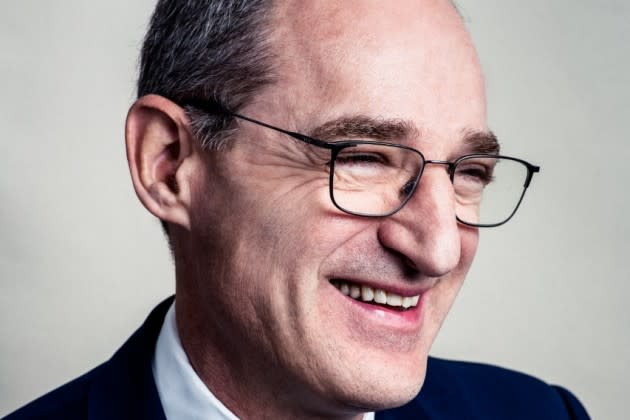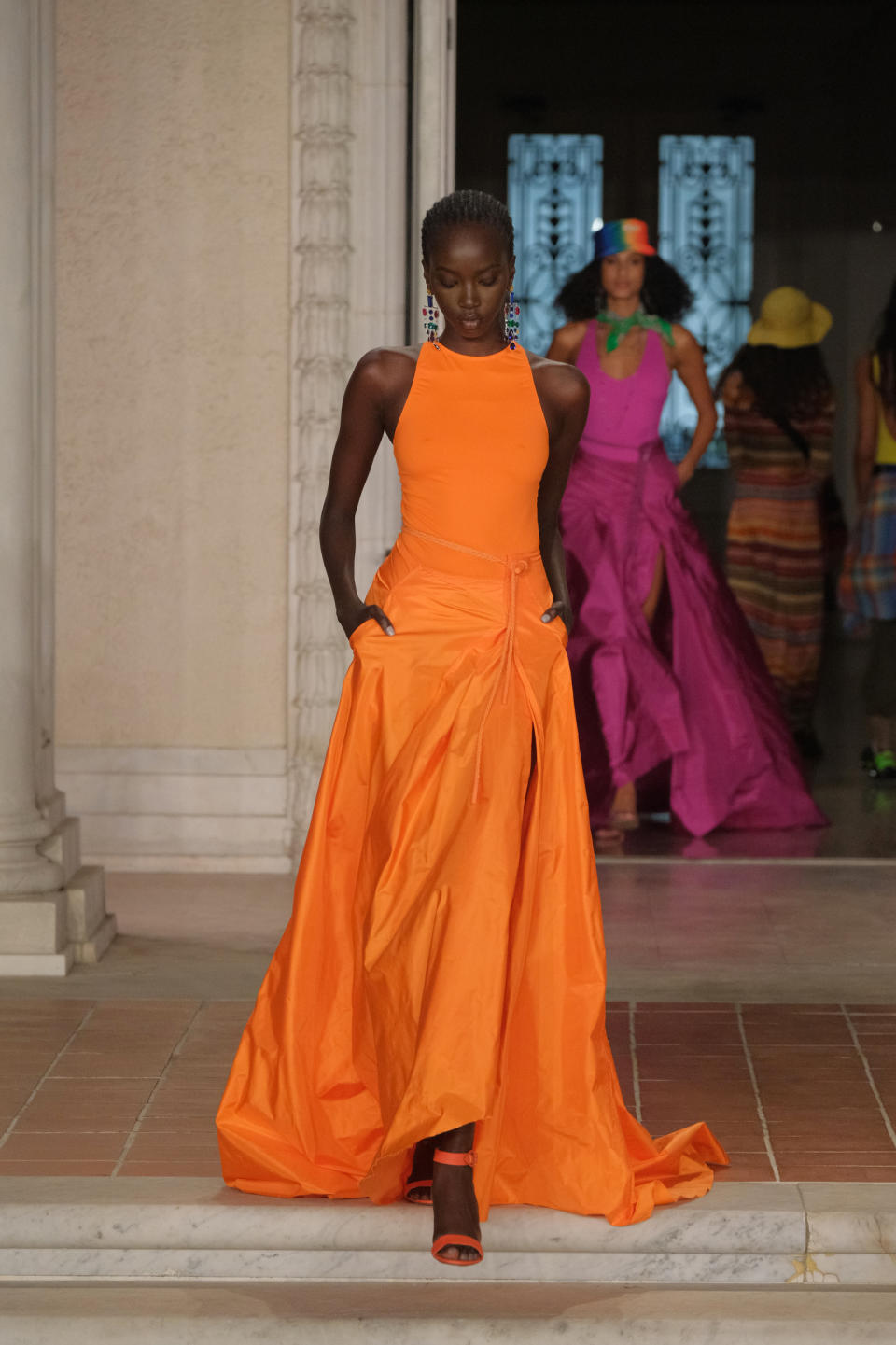Patrice Louvet on Ralph Lauren’s Ability to Create Magic
- Oops!Something went wrong.Please try again later.

NEW YORK — What do Ralph Lauren and the Walt Disney Co. have in common? They’re both masters at creating worlds that people want to immerse themselves in.
That was the way Patrice Louvet, president and chief executive officer of Ralph Lauren Corp., described the company’s founder during a breakfast meeting with the French Institute: Alliance Francaise here Thursday morning.
More from WWD
“I actually think this company is much closer to Disney than it is to other apparel brands,” he said during a conversation with author and business analyst Erwan Rambourg. “Ralph is not a designer. Ralph is actually more of a movie director. I think he’s close to the Martin Scorsese actually, because he has this unique ability to imagine these worlds. Do you want to be a cowboy in the West? Do you want to be a businesswoman on Wall Street or an athlete at the Olympics? Ralph creates these worlds and then invites people into these worlds — similar to the movie industry.”
Even though more than half of Ralph Lauren Corp.’s business is outside the U.S., the company has managed to bring its American-based values of “entrepreneurship, optimism, family, freedom,” to every country in which it does business. “Our purpose is to inspire the dream with a better life, through authenticity and timeless style, and we’re finding that resonates everywhere,” Louvet said.
He said Ralph Lauren has become adept in blending “magic and logic” — a skill that any company needs to be successful.
RELATED: Ralph Lauren RTW Spring 2023
“I spent most of my career in the logic world, but what I found in the fashion world is more inspiration, more emotion. The consumer needs to react with their heart and their head. Companies that do it best are able to get the right balance between the magic and the logic.”
Louvet, who spent close to 30 years at Procter & Gamble before joining Ralph Lauren a little more than five years ago, said big corporations like his former employer could benefit from creating a little more magic in their products while fashion firms often need to enhance their operational discipline and analytics.
“But I am always very wary not to kill the magic,” he stressed. “It’s very easy to implement a whole bunch of logic approaches, but if it doesn’t get the consumer excited, it’s worthless.”
Even so, it hasn’t been all wine and roses in the 56 years that Ralph Lauren has been in business. After decades of growth, about 10 years ago, “things started to slow,” Louvet said. Because the company had gone public, there was pressure from Wall Street to continue to perform every quarter, and as a result, “the brand had overextended, particularly in the U.S., over-distributed and over-promoted in search for volume and growth. I remember when I came into the job, one of the first questions I asked our teams was: what our name was on the website — was it 30 percent off or Ralph Lauren?”
So Louvet set out to change the brand’s positioning. “Our aspiration is to be the leading luxury lifestyle company in the world,” he said.
To achieve that goal, he spearheaded a dramatic pivot in the brand’s way of operating that included elevating the quality and style of the product, cutting two-thirds of its wholesale distribution to focus on retailers who “could represent the brand in the right way,” eliminated 50 percent of its off-price customer base, and “dramatically reduce[d] our promotional activity.”
While drastic, these strategies have paid off, Louvet said, with the average unit retail prices rising 70 percent over the past four years. “The consumer would not have followed us if they didn’t see increased value,” he said.
In addition, in a recent survey, he said, 80 percent of consumers said they believed Ralph Lauren is a luxury brand.
“So we’re making good progress, but we still have a long way to go,” he said.
That positioning is also helping Ralph Lauren navigate the current challenging environment.
Like nearly all fashion businesses, the pandemic also took a toll on Ralph Lauren, but the company managed to bounce back when things reopened. Louvet said that despite a slowdown among more value-oriented consumers due to inflationary pressures, the company’s core consumer has proven to be “pretty resilient. They’re continuing to come to our stores and our website. We’ve done a lot of work over the past few years to elevate our customer base. They’re less price-sensitive, younger, more diverse — we brought in 1.6 million new consumers over the past quarter — so from that standpoint, we are confident that this will continue.”
Outside the U.S., Louvet said the situation is similar. Although China only represents around 6 percent of the company’s overall sales today, since the country reopened in January, sales have bounced back “with a vengeance.” And when the Chinese consumer begins traveling again, he’s expecting business to get even stronger.
Going forward, he said Ralph Lauren will focus on increasing its presence in six top Chinese cities including Taipei, Hong Kong, Shanghai and Beijing where it will build “ecosystems” consisting of flagships, Polo boutiques, strong wholesale partnerships and a digital presence on top local platforms.
And beyond China, Louvet said there are also opportunities for growth in international markets such as Germany as well as in the Western U.S., where the brand is still underrepresented.
In terms of product categories, Louvet said womenswear is among the categories with the most potential. Although 56 percent of all Ralph Lauren customers are female, only 20 to 25 percent of sales are womenswear, he said, representing a “massive opportunity” to encourage women to shop for themselves, not just the men and children in their lives.

Even so, the company pulls in more than $1 billion in womenswear sales, a number Louvet expects to grow substantially in the future. The trick, however, is to ensure that in targeting women, the company doesn’t lose its historic strength in menswear.
The home area is also seen as a category with “a lot of runway,” he continued, as is outerwear, which has managed to double its business in the past five years and now represents 10 percent of overall sales.
Hospitality also represents an interesting opportunity for the future, he said. The corporation now operates five restaurants and 30 coffee shops around the world that connect with more than 2 million consumers annually. Ralph’s on the Upper East Side in New York has become a hot spot.
“Now, what does a tie-maker know about coffee,” he asked. “It’s not necessarily about category expertise, it’s also about the experience and the story. We view it more as an opportunity to engage with the consumer and provide them with a different experience to discover the brand.”
He also didn’t rule out eventually expanding the brand into the hotel business, saying it would be “cool” to explore a Western-themed Double RL resort or a luxury Purple Label hotel, but that would be down the road as Louvet sees more immediate projects in which to invest.
Those include the metaverse and sustainability — both of which are of upmost importance to young people. In addition to product and marketing partnerships with Roblox and Fortnite, the company is also increasing the circularity of its products and exploring the rental market
“Now the good news is if there’s one word that is synonymous with Ralph Lauren, it’s timelessness,” he said. “Ralph has always said, ‘I want my products to be loved and worn and passed on to next generations.’ And [through my] five-year journey, our revenue is higher, but our units are lower. So for us, that continues to be the core to our overall strategy.”
Since Louvet was speaking to a group of French executives, the issue of his native country was also addressed. Although he hasn’t lived in France for 27 years, he said his upbringing there left an indelible mark and has helped him to navigate the luxury market successfully.
“I don’t know how much Frenchness is left,” he said with a smile, “but having grown up in France, we are surrounded by the luxury environment. It’s part of our DNA. I think part of the education in France is the sensitivity to history, heritage, aesthetics. And I think that ultimately helped later on in this space.”
At P&G, Louvet had oversee global beauty, but he played that down, saying that he had also been brand manager of the Pampers diaper brand — hardly a luxury product.
“I don’t come from this industry,” he said. But over the course of his career, he learned some valuable lessons. One traces back to a Greek philosopher who said we have two ears and one mouth for a reason: we need to listen more than we talk, which has become one of his “guiding principles.”
A second lesson is “this notion of constant learning,” he said. “I think it was Einstein who said, ‘When you stop learning, you start dying.’ And the man I partner with on a daily basis now, [Ralph Lauren], is an incredible example of that.”
Best of WWD

